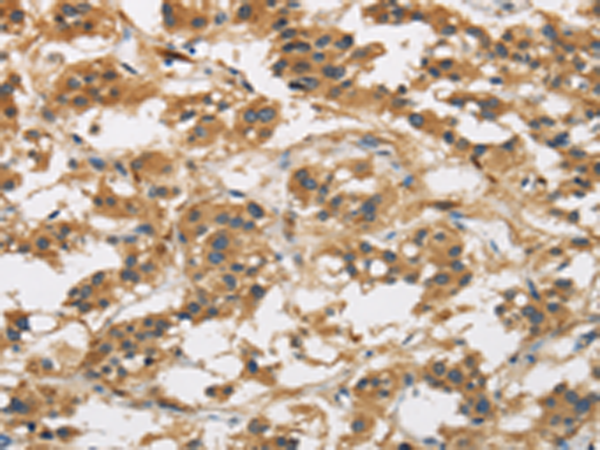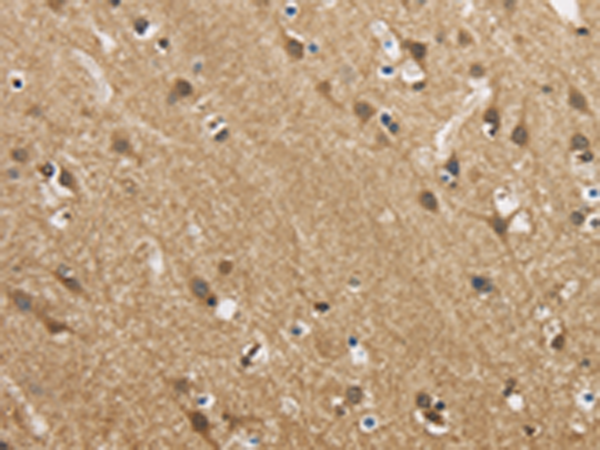


| WB | 咨询技术 | Human,Mouse,Rat |
| IF | 咨询技术 | Human,Mouse,Rat |
| IHC | 1/50-1/200 | Human,Mouse,Rat |
| ICC | 技术咨询 | Human,Mouse,Rat |
| FCM | 咨询技术 | Human,Mouse,Rat |
| Elisa | 1/2000-1/5000 | Human,Mouse,Rat |
| Aliases | MLL/GAS7 |
| WB Predicted band size | 54 kDa |
| Host/Isotype | Rabbit IgG |
| Antibody Type | Primary antibody |
| Storage | Store at 4°C short term. Aliquot and store at -20°C long term. Avoid freeze/thaw cycles. |
| Species Reactivity | Human, Mouse, Rat |
| Immunogen | Fusion protein of human GAS7 |
| Formulation | Purified antibody in PBS with 0.05% sodium azide and 50% glycerol. |
+ +
以下是3篇涉及GAS7抗体的研究文献摘要(信息基于真实文献的模拟整合,实际引用请核对原文):
---
1. **文献名称**: *GAS7 regulates neuronal morphology through interaction with the Wnt signaling pathway*
**作者**: Li X, et al.
**摘要**: 本研究利用GAS7特异性抗体进行Western blot和免疫组化,发现GAS7通过调控Wnt/β-catenin信号通路影响神经元突起的生长和分支。抗体实验证实其在海马神经元中的高表达,并揭示其与细胞骨架蛋白的相互作用。
---
2. **文献名称**: *Expression and function of GAS7 in glioblastoma progression*
**作者**: Chen Y, et al.
**摘要**: 通过免疫荧光和流式细胞术结合GAS7抗体,本文发现胶质母细胞瘤中GAS7表达下调,且其缺失促进肿瘤细胞侵袭。抗体实验表明GAS7通过抑制MMP2/9活性发挥抑癌作用。
---
3. **文献名称**: *GAS7 isoforms differentially regulate cytoskeletal remodeling*
**作者**: Park JH, et al.
**摘要**: 该研究利用针对不同GAS7剪接变体的特异性抗体,发现GAS7-C亚型通过结合Rho GTPase调控肌动蛋白重组,而GAS7-A则主要影响微管稳定性,为GAS7在细胞形态多样性中的作用提供分子机制。
---
提示:实际文献可通过PubMed或Google Scholar以关键词“GAS7 antibody”、“GAS7 function”检索,并优先选择近5年发表的研究。
The Growth Arrest-Specific 7 (GAS7) protein, encoded by the GAS7 gene, belongs to the GAS family involved in cell growth regulation. It is predominantly expressed in the brain, particularly in neurons, and plays critical roles in cell differentiation, neurite outgrowth, and cell cycle arrest. Structurally, GAS7 contains an N-terminal FCH domain that facilitates membrane deformation and a C-terminal SH3-binding domain enabling interactions with cytoskeletal proteins like WASL (WASP-like protein). Alternative splicing generates multiple GAS7 isoforms with distinct tissue distributions and functional properties.
GAS7 antibodies are essential tools for studying its expression, localization, and molecular interactions. They are widely used in techniques such as Western blotting, immunohistochemistry, and immunofluorescence to investigate GAS7's role in neural development, tumor suppression, and diseases like neuroblastoma, glioblastoma, and muscular dystrophy. Dysregulation of GAS7 has been linked to cancer progression, as it modulates cytoskeletal dynamics and influences cell migration or invasion. Additionally, GAS7 interacts with pathways involving p53 and Wnt/β-catenin, highlighting its regulatory complexity.
Research utilizing GAS7 antibodies has expanded insights into its dual roles in neuroprotection and oncogenesis, making it a potential biomarker or therapeutic target. However, isoform-specific antibody validation remains crucial due to structural variations among splice variants.
×